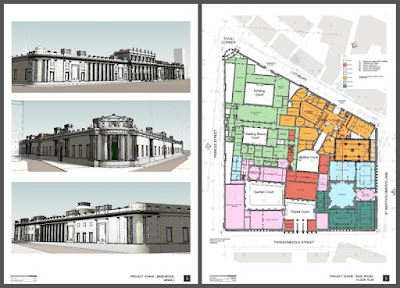Sir Robert passed on. The old lady
had the nerve to approach a quirky young man with fire in his belly. John Soan,
inclined to add an "e"
to his name. Pretentious and prickly but determined to
succeed, to rise from his humble beginnings and shine like gold. Like the gold
in the vaults below the banking halls and offices.
Soane gave 45 years to the old lady. Guided her through
a complete transformation, the mother of all makeovers perhaps. A strange
combination of classical tradition, picturesque romanticism, and personal
vision. What a romance. Sadly it was all undone, through war once again.
Expansion sideways gave way to vertical growth.
But that's another story for another day.
Son of a bricklayer, noticed and
nurtured by a wealthier sort. Soane took the grand tour to Italy and cavorted
with Bishops. He developed a highly individual style, part Roman part Romantic.
He brought light into rooms from unexpected directions
often filtered through yellow glass. Top lighting did double work at the bank:
security and the ability to pack spaces tightly together. The old ladies
parlours changed almost as quickly as the money passing through. Never enough
seats for all her servants. Musical chairs the perennial game.
Soane craved a grand Palace project with freedom to express grand symmetry. But he really excelled at improv and packing drama into tight and awkward spaces. You can't always get what you want...
He didn't really want the bank but it became his masterwork. The bank didn't really want his architectural sophistry, but it became a lasting symbol of their achievement, adapting to changing conditions over three centuries. Helping to usher in the modern world. Steam and steel. Rail and cotton. Paper money. Stable currency.
Did I mention that the old lady took
a fourth husband? (after a period of mourning Mr Soane's passing while allowing
younger fellows to tinker around with his vision)
There were two great wars that changed the bank in
profound ways. In between these, the old lady took up with a certain Mr Baker,
a new sort of man. Head in the neoclassical clouds, feet on solid commercial
ground.
Mr Baker tore everything down and started again, though
with some pretence at retaining the ghost of Mr Soane. He built a stiff and
pompous tribute to the modern world, frozen classicism of great skill but not
much soul, a mish-mash of Soane and Wren, it seems to me. Appropriate to its
time no doubt.
Much more could be said I'm sure but let's hang this
washing out on the line and see how it looks in the sunshine. Momentous times
in the history of England seen through the prism of a building that just grew
and grew, shaped itself to circumstance, sits there now like a hollow shell.
Through the magic of the BIM pencil, I have been able
to peer into the old lady's complex history. If stones could speak, what a
story they might tell.
Photos courtesy of my son.
Reflecting on transition. Giles G Scott was the "external architect"
for this coal-fired power station which has transitioned into an up-market,
mixed-use iconic mega-structure.
Scott himself lived through transition from a third generation
Gothic revivalist to a proto-modern with his stripped down aesthetic of
dramatic multi-ribbed brickwork, strangely reminiscent of Klint's Copenhagen
churches.
And now we are agonising our way through an energy
transition. I'm certainly not going to see how it plays out. I do hope that
cooler heads prevail, that the frantic finger pointing gives way to sensible
long term strategy.
This building is not just a cultural icon. It provided
electricity to several generations of Londoners transitioning into the modern
world of radio, television, indoor plumbing, washing machines... A transition
very familiar from my childhood years, when a man with a horse and cart would
hump a sack of coal on his shoulder and heavy it down into the coal cellar
below the path to our front door.
We've come a long way. These things take time.





No comments:
Post a Comment
I've been getting a lot of spam so had to tighten up comments permissions. Sorry for any inconvenience. I do like to hear from real people